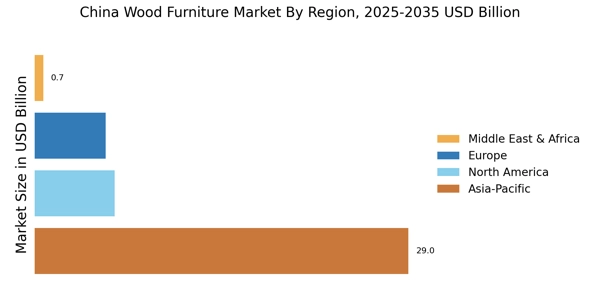Rising Disposable Income
The increasing disposable income among the Chinese population appears to be a pivotal driver for the China Wood Furniture Market. As consumers gain more financial freedom, they tend to invest in higher-quality furniture that reflects their lifestyle and preferences. Reports indicate that the average disposable income in urban areas has seen a steady rise, which correlates with a growing demand for premium wood furniture. This trend suggests that consumers are willing to pay a premium for sustainable and aesthetically pleasing products, thereby enhancing the market's growth potential. Furthermore, the urbanization trend in China, with more individuals moving to cities, is likely to further boost the demand for wood furniture, as urban dwellers often seek to furnish their homes with stylish and functional pieces.
Growing Environmental Awareness
There is a noticeable shift towards sustainability and eco-friendliness among consumers, which serves as a crucial driver for the China Wood Furniture Market. As awareness of environmental issues rises, consumers are increasingly inclined to choose furniture made from sustainably sourced materials. This trend is reflected in the growing demand for certified wood products, which adhere to environmental standards. Reports indicate that the market for eco-friendly furniture is expanding, with consumers willing to pay more for products that are both stylish and sustainable. This shift not only influences purchasing decisions but also encourages manufacturers to adopt sustainable practices, thereby enhancing their market competitiveness. Consequently, the focus on sustainability is likely to shape the future landscape of the wood furniture market in China.
Urbanization and Housing Development
The rapid urbanization in China is a significant driver for the China Wood Furniture Market. As more people migrate to urban areas, the demand for housing increases, leading to a surge in residential construction. This trend creates a substantial market for wood furniture, as new homeowners and renters seek to furnish their living spaces. Data suggests that urban areas are expected to house over 70% of the population by 2030, which could lead to an increased demand for various types of wood furniture, from basic essentials to luxury items. Additionally, the government’s initiatives to promote affordable housing may further stimulate the market, as these developments often require substantial furnishing, thereby providing opportunities for wood furniture manufacturers.
E-commerce Growth and Online Retailing
The expansion of e-commerce platforms is significantly influencing the China Wood Furniture Market. With the increasing penetration of the internet and mobile devices, consumers are increasingly turning to online shopping for their furniture needs. This trend is supported by data showing that online retail sales in China have been growing at a remarkable pace, with furniture being one of the top categories. E-commerce not only provides consumers with a wider selection of products but also enhances convenience, allowing for easy price comparisons and access to customer reviews. As more consumers embrace online shopping, furniture retailers are likely to invest in their online presence, thereby expanding their reach and potentially increasing sales. This shift towards e-commerce is expected to continue shaping the dynamics of the wood furniture market in China.
Technological Advancements in Manufacturing
Technological innovations in manufacturing processes are transforming the China Wood Furniture Market. The adoption of advanced machinery and automation has led to increased efficiency and precision in furniture production. This evolution allows manufacturers to produce high-quality products at a lower cost, which can enhance profit margins and market competitiveness. Moreover, the integration of technology in design processes enables customization, catering to the diverse preferences of consumers. Data indicates that the use of computer-aided design (CAD) and other technologies is on the rise, facilitating the creation of unique and intricate designs that appeal to modern consumers. As technology continues to evolve, it is likely to play a crucial role in shaping the future of the wood furniture market in China.


















Leave a Comment